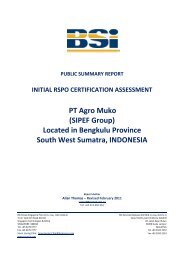PT Tolan Tiga Indonesia (SIPEF Group) Sumatra, INDONESIA
PT Tolan Tiga Indonesia (SIPEF Group) Sumatra, INDONESIA
PT Tolan Tiga Indonesia (SIPEF Group) Sumatra, INDONESIA
Create successful ePaper yourself
Turn your PDF publications into a flip-book with our unique Google optimized e-Paper software.
RSPO Certification Assessment – <strong>Tolan</strong> <strong>Tiga</strong> <strong>Indonesia</strong> Mills and Supply Base Page 14<br />
TIGA <strong>INDONESIA</strong> property into downstream users. There<br />
are water quality tests which monitor river water quality<br />
both upstream and down stream - these are carried out<br />
when requested and results have indicated that water<br />
quality of other users has not been adversely effected -<br />
This is completed by an independent lab and show pH,<br />
TSS, Heavy metals, BOD, COD, Faecal and Total coli form.<br />
Water contamination is avoided for both surface and<br />
ground water during normal conditions – during<br />
abnormal conditions (that is very heavy rain) it is not<br />
possible to avoid all contamination.<br />
Hazardous Chemicals are prevented from entering water<br />
via good management practices including: Pre-mixing of<br />
pesticides in dedicated areas, use of secure storage, use<br />
of bunding – no mixing of chemicals etc. is carried out in<br />
proximity to water courses.<br />
TOLAN TIGA <strong>INDONESIA</strong> have put in place a controlled<br />
contaminated waste area in each estate (B3) for<br />
management of all containers and other pesticide waste,<br />
are keeping records of containers destroyed and sent to<br />
pesticide pit, ensure correct dilution of fertiliser is used<br />
for field application, monitor ground water to ensure no<br />
contamination from septic.<br />
Control also includes improved and correct storage of<br />
bulk chemicals and fertiliser, control of hydrocarbons to<br />
prevent contamination - provision of bunds, spill kits and<br />
drip trays.<br />
Mill Effluent is treated appropriately and appears<br />
effective. The records of monitoring of effluent are in<br />
place however testing is now following a controlled<br />
methodology to ensure results are consistent. POME is<br />
used for Land application - are within allowable legal<br />
limits<br />
When the lab is recording results they are indicating the<br />
allowable limits to determine quickly that they are<br />
within tolerance.<br />
Some emplacements are collecting and using rain water<br />
- <strong>PT</strong> TTI need to find out if quantities and use are<br />
measured.<br />
BOD of effluent is monitored with regards to land<br />
application and government limits. This is reported<br />
monthly by an independent lab (SUCOFINDO). Levels are<br />
all within legally allowed limits for land application.<br />
Records of BOD of land application are recorded.<br />
Criterion 4.5: Pests, diseases, weeds and invasive<br />
introduced species are effectively managed using<br />
appropriate Integrated Pest Management (IPM)<br />
techniques.<br />
The Integrated Pest Management plan has now been<br />
documented – this includes all Integrated Pest<br />
management techniques used in each estate. This<br />
includes use of barn owls for rat control, planting of<br />
beneficial plants as well as use of pesticides etc. thereby<br />
minimising the use of chemicals and pesticides.<br />
An IPM Program is therefore to be documented for<br />
relevant pests that sets out techniques, chemicals to be<br />
used, locations and timeframe for implementation.<br />
At times were possible non chemical methods are used<br />
to control pests in preference to chemicals. Examples<br />
include use of barn owls against rats.<br />
There are training records for training of staff in regards<br />
to IPM however these do not appear to be formally<br />
recorded on all occasions and improvement is required<br />
in these areas. Training records are now available for<br />
IPM training.<br />
The implementation is monitored and includes number<br />
of barn owls and boxes. The extent of planting of<br />
beneficial plants is noted and recorded. There have been<br />
infestations of oryctes and this is managed through IPM<br />
using pheromones. This is ongoing and progress<br />
continues to be monitored through the IPM including<br />
the effectiveness of pheromones in place. The strategy<br />
includes moving of pheromones were infestations have<br />
been recorded. There is a pest census in all areas via the<br />
use of pheromones and also the prominence of rats. Any<br />
pest incidences are therefore monitored to determine<br />
success of the IPM. This is completed at least monthly in<br />
all estates.<br />
The progress and success of the implantation of the IPM<br />
are now reported on a regular basis in a formal manner.<br />
TOLAN TIGA <strong>INDONESIA</strong> is now monitoring pesticide<br />
toxicity units (a.i. x LD 50 / tonne of FFB). This is<br />
recorded back to January 2007. The trend analysis<br />
indicates use of Glyphosate in the early period indicated<br />
a tendency to increase and has recently started to fall. At<br />
the same time the use of paraquat and declined steadily<br />
to around 30% of amount used at the commencement of<br />
recording of usage.<br />
The Pest Management Plan (PMP) has been recently<br />
updated and includes the control of all pesticides and<br />
the methodology for both reducing use of pesticides and<br />
/ or changing to less toxic chemicals. The use of all<br />
chemicals is justified and a plan to reduce usage has<br />
been presented. This includes chemicals used, dosages,<br />
and frequency of use.<br />
Criterion 4.6: Agrochemicals are used in a way that<br />
does not endanger health or the environment. There is<br />
no prophylactic use of pesticides, except in specific<br />
situations identified in national Best Practice<br />
guidelines. Where agrochemicals are used that are<br />
categorised as World Health Organisation Type 1A or<br />
1B, or are listed by the Stockholm or Rotterdam<br />
Conventions, growers are actively seeking to identify<br />
alternatives and this is documented.<br />
Prepared by BSi Management Systems Singapore Pte Ltd for <strong>PT</strong> <strong>Tolan</strong> <strong>Tiga</strong> <strong>Indonesia</strong> / <strong>SIPEF</strong> <strong>Group</strong>




